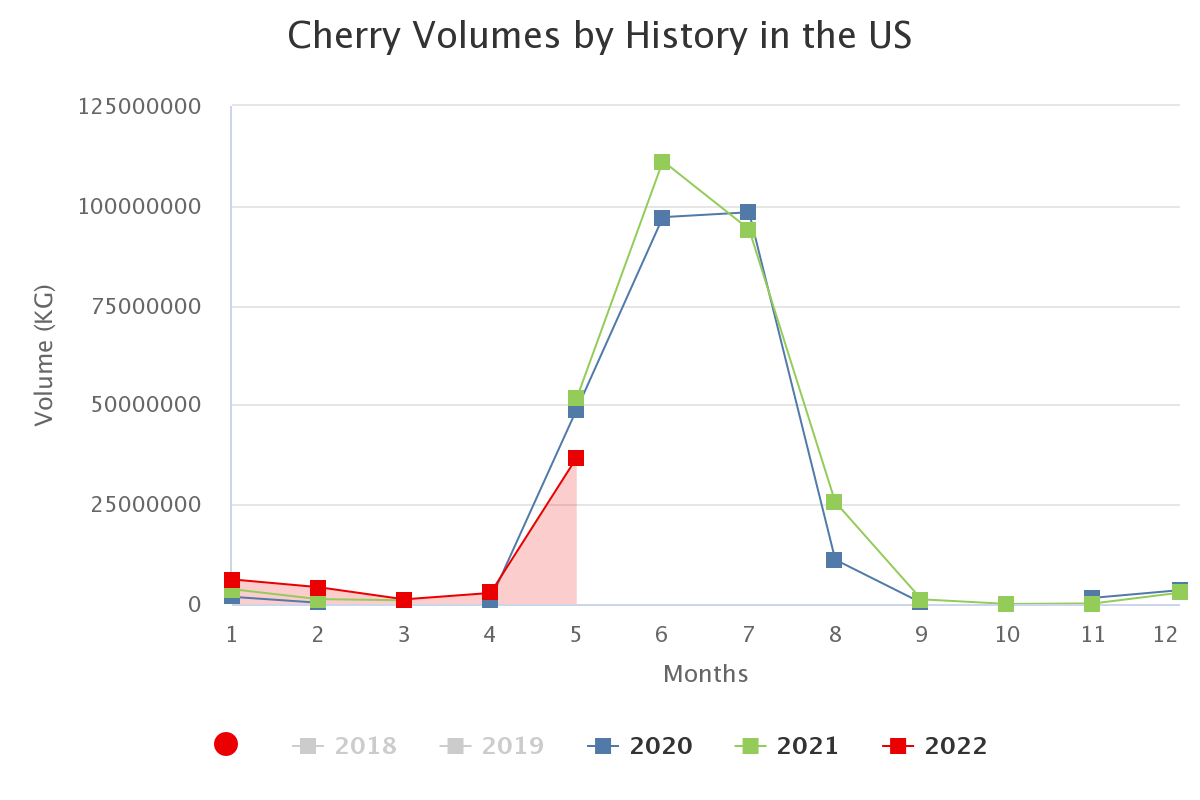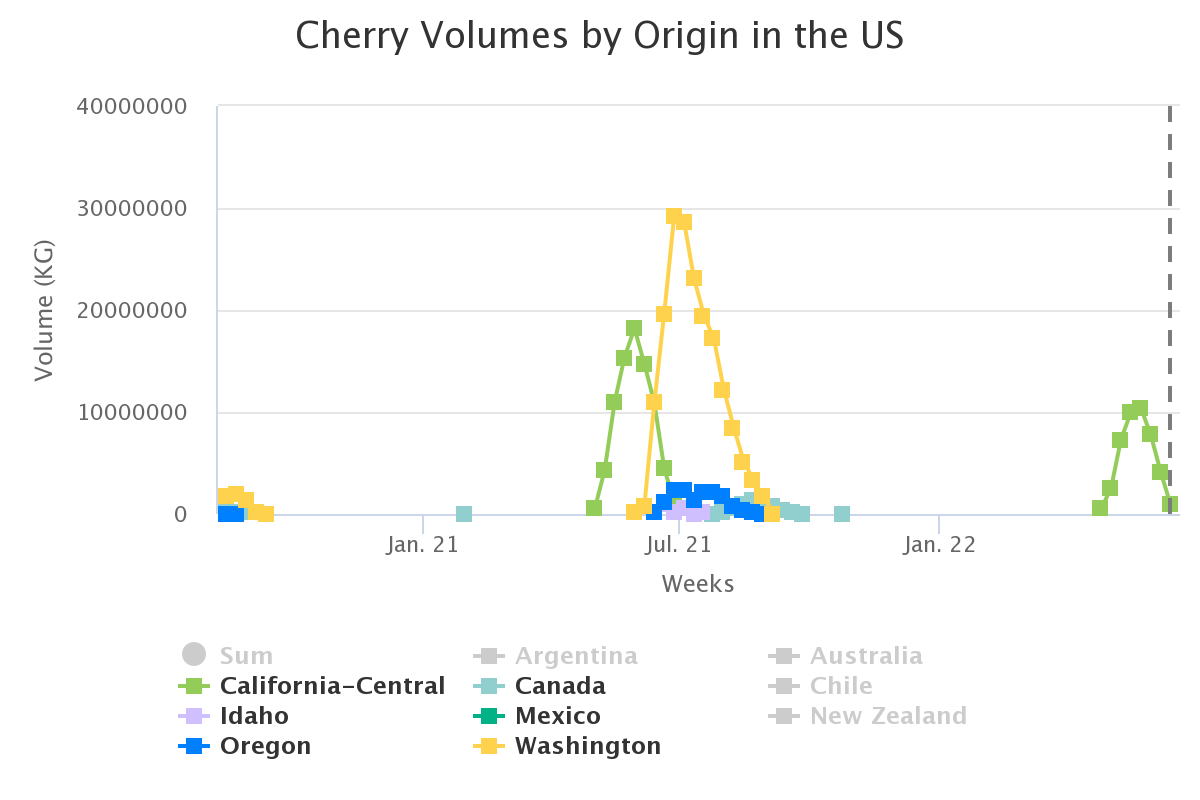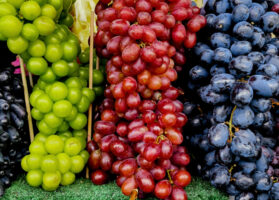GLOBAL OVERVIEW CHERRIES
Overview of cherries in the U.S. market, complemented by charts from Agronometrics. Original published on June 10, 2022.
North America: Up to 50% less production in areas
Prices on the North American market for cherries are around 5.2% higher than usual than the yearly average, due to adverse weather conditions during the growing season. The combination of snow and frost damaged buds, and has also caused delays in some production areas, causing increasing worried about the financial sustainability of the sector, as production and logistics costs continue to soar. The various production areas have been affected by these conditions to various extents.

Source: USDA Market News via Agronometrics.
(Agronometrics users can view this chart with live updates here)
California’s cherry harvest is estimated to be down close to 50% of what is considered an average year, as a freeze in late February negatively impacted the crop. This freeze was followed by an unusual amount of rain in April, a critical time, when the cherries were closer to maturity. Due to these factors causing a smaller crop, the fruit size is larger on average. Harvest for the state ended abruptly, a few California cherries were packed this week (nothing exportable), but the state is now done for the season.
The Washington cherry season is not only getting a later start this year, but it will also see a reduced crop.
“We’re forecasting between 50-60 percent of the crop, depending on the timing. The volume is down significantly and there’s still a whole lot of uncertainty because the weather has been pretty dicey up to date,” says one Washington-based grower-shipper.
Behind the reduced crop is of course the weather. “We had a freakish April snow/freeze combination during bloom. None of us had ever seen weather like that before,” he says, noting the lower temperatures lasted between a week to 10 days at what would historically be bloom time. “Following that, we got quite a bit of precipitation and no warm days. This week is the first hint at warm temperatures. We’ve spent a very very little amount of time above 70 degrees in the Northwest which normally we’d have several hundred hours by now.”
Not only is this affecting the overall crop size but the start date is pushed back until the middle of June when normally the region would be packing cherries already. “There’s going to be a bit of a gap in the market. We’ll have a full week where neither state is shipping cherries,” says the grower-shipper who adds that California may still have some cherries this week and that leaves that week to 10-day period before Washington gets into any real volume of cherries.
Shipping will likely go until the middle of August. “The whole state is behind so it’s spread out. June will be very light, July will be wherever the peak of availability will be and then August we’ll spend a few weeks heading towards a conclusion,” he says.

Source: USDA Market News via Agronometrics.
(Agronometrics users can view this chart with live updates here)
However the crop that is available looks good on quality. “Sizing is middle of the road. There will be some super large fruit sizes but as far as the bell curve goes, we’re right in the middle with 10.5-11 sizing for a large portion of the season,” he says.
But given the predicted yields, harvest may be counter weighted against costs. “With the high labor costs, does it and increased cost inputs such as fuel and packaging supplies, merit us to go in and pick one to two tons per acre? Will be price structure support that? That’s still an uncertainty,” says the grower-shipper.
What is certain is that stronger pricing is on the way factoring in those higher costs and lower yields. He notes it will be difficult to balance the right pricing at retail. Nobody wants higher prices to discourage consumers, though another factor in that equation is the limited season North American cherries have and its position as a consumer favorite.
Looking ahead though, what’s the bigger picture for North American cherries? “We’ve had three seasons in a row, each with a unique set of challenges few of us have seen before. Last year it was 118-degree heat in early July and this year is the topper with freezing temperatures in April. The two extremes are hard to defend against,” he says.
However along with evolving growing practices, varieties are developing too and moving towards more resilient options and more fertile, self-pollinating choices. “It’s evolving. But Mother Nature needs to give us a break one of these years and give us a full crop,” says the grower-shipper.
Yet, despite the challenges, there’s still optimism for the season. “We’re looking forward to providing something different. It’s one of the most vibrant items in the produce department that everyone looks forward to seasonally,” he adds.
Growers in British Columbia, Canada, will start harvest about 10 days later than usual, around July 10 instead of the normal July 1 date. Volume will be light at first, but will ramp up at the end of July. The later start is caused by cool weather during spring, which delayed bloom. It didn’t adversely affect the crop, as it did in other regions in North America, but it did delay maturity. The harvest is expected to continue until September 8-10.
The province expects a crop size that is about 75% of what they had initially projected. So, a smaller crop than expected, but the fruit is sizing up nicely. Last year, volumes were high, but the size was small. This year, the crop is forecast to be smaller, but the fruit size is expected to be bigger. It will be healthy for the market to start harvest late because it means there will be less overlap with Washington State. The majority of BC’s cherry crop will hit the market in August and September and during that time, there will be no competition left in the market. Although harvest for BC is still far out, the industry is cautiously optimistic. It is perfect cherry weather at the moment with temperatures between 20 and 24°C. Strong demand is expected, also from export markets. As a result, the province expects to ship more overseas this year than last year. In addition to Canada and the US, main markets for BC cherries are Europe, the Middle East and Southeast Asia.
The News in Charts is a collection of stories from the industry complemented by charts from Agronometrics to help better tell their story.
Access the original article with this (Link)






